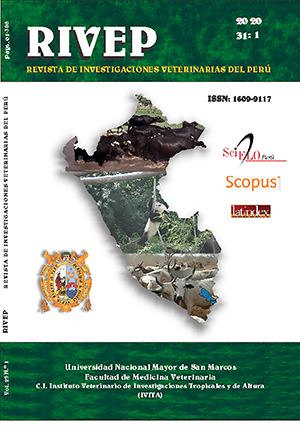Monogenean ectoparasites in juveniles of Cichla monoculus from the Tarapoto lake, Nanay river, Peru
DOI:
https://doi.org/10.15381/rivep.v31i1.15713Keywords:
Cichla monoculus, monogeneans, cocha Tarapoto, Nanay, PeruAbstract
The aim of this study was to identify the monogenean ectoparasites and the parasitic indices of juveniles of Cichla monoculus from the Tarapoto lake, Nanay river, Peru, between July and September 2011. Thirty juveniles were examined (35.9 ± 14.0 g and 14.46 ± 1.97 cm). The fins, nostrils and branchial arches were removed and placed in a petri dish with distilled water for the search of monogeneans. The parasites were fixed in glycerin ammonium-picrate (GAP) to observe the sclerotized structures. There were 2343 monogeneans in the gills and 240 individuals were collected for identification. Three species were identified: Gussevia longihaptor (prevalence = 80%, mean intensity = 5.21 parasite/fish, mean abundance = 4.17 parasite/fish), Gussevia undulata (prevalence = 70%, mean intensity = 4.95 parasite/fish, mean abundance = 3.47 parasite/fish) and Sciadicleithrum ergensi (prevalence = 23.3%, mean intensity = 1.57 parasite/fish, mean abundance = 0.23 parasite/fish). The first two species are considered central species, while the third is considered a satellite species. Likewise, S. ergensi is reported for the first time in Peru and in Cichla monoculus.
Downloads
Downloads
Published
Issue
Section
License
Copyright (c) 2020 HUMBERTO ARBILDO ORTIZ

This work is licensed under a Creative Commons Attribution-NonCommercial-ShareAlike 4.0 International License.
AUTHORS RETAIN THEIR RIGHTS:
a. Authors retain their trade mark rights and patent, and also on any process or procedure described in the article.
b. Authors retain their right to share, copy, distribute, perform and publicly communicate their article (eg, to place their article in an institutional repository or publish it in a book), with an acknowledgment of its initial publication in the Revista de Investigaciones Veterinarias del Perú (RIVEP).
c. Authors retain theirs right to make a subsequent publication of their work, to use the article or any part thereof (eg a compilation of his papers, lecture notes, thesis, or a book), always indicating the source of publication (the originator of the work, journal, volume, number and date).



